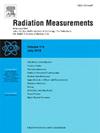基于声纹识别的中子-伽马识别方法
IF 2.2
3区 物理与天体物理
Q2 NUCLEAR SCIENCE & TECHNOLOGY
引用次数: 0
摘要
针对脉冲中子辐射场先验知识有限的问题,提出了一种基于声纹识别理论的中子/伽马脉冲形状识别方法。该方法主要包括五个步骤:Mel-Frequency Cepstral系数的特征提取、通用背景模型(UBM)的训练、中子/高斯混合模型(GMM)的自适应训练、模型验证和应用。对于商用有机闪烁体探测器提供的1000个小样本训练集,该方法的精度高达99%,与经典电荷积分方法相当。在不同实验条件下得到的波形用于无监督识别。结果表明,该方法具有精度高、特征提取能力强、泛化能力强、适应性强、计算速度快等优点。本文章由计算机程序翻译,如有差异,请以英文原文为准。
Neutron-gamma discrimination method based on voiceprint identification
Aiming at the limited prior knowledge from the pulsed neutron radiation field, a new method for neutron/gamma pulse shape discrimination (PSD) is proposed based on the theory of Voiceprint Identification (VI). This method primarily involves five steps: feature extraction of Mel-Frequency Cepstral Coefficients, training of a universal background model (UBM), adaptive training of neutron/gamma Gaussian Mixture Model (GMM), model verification, and application. For 1000 small sample training sets provided by commercial organic scintillator detectors, the accuracy of this method was proven to be as high as 99 %, comparable to the classical charge integral method. The waveforms obtained under varying experimental conditions were used for unsupervised discrimination. The results demonstrate that this method offers high accuracy, robust feature extraction capabilities, strong generalization abilities, exceptional adaptability, and rapid computational speed.
求助全文
通过发布文献求助,成功后即可免费获取论文全文。
去求助
来源期刊

Radiation Measurements
工程技术-核科学技术
CiteScore
4.10
自引率
20.00%
发文量
116
审稿时长
48 days
期刊介绍:
The journal seeks to publish papers that present advances in the following areas: spontaneous and stimulated luminescence (including scintillating materials, thermoluminescence, and optically stimulated luminescence); electron spin resonance of natural and synthetic materials; the physics, design and performance of radiation measurements (including computational modelling such as electronic transport simulations); the novel basic aspects of radiation measurement in medical physics. Studies of energy-transfer phenomena, track physics and microdosimetry are also of interest to the journal.
Applications relevant to the journal, particularly where they present novel detection techniques, novel analytical approaches or novel materials, include: personal dosimetry (including dosimetric quantities, active/electronic and passive monitoring techniques for photon, neutron and charged-particle exposures); environmental dosimetry (including methodological advances and predictive models related to radon, but generally excluding local survey results of radon where the main aim is to establish the radiation risk to populations); cosmic and high-energy radiation measurements (including dosimetry, space radiation effects, and single event upsets); dosimetry-based archaeological and Quaternary dating; dosimetry-based approaches to thermochronometry; accident and retrospective dosimetry (including activation detectors), and dosimetry and measurements related to medical applications.
 求助内容:
求助内容: 应助结果提醒方式:
应助结果提醒方式:


